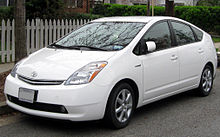
A hybrid vehicle is one that uses two or more distinct types of power, such as submarines that use diesel when surfaced and batteries when submerged. Other means to store energy include pressurized fluid in hydraulic hybrids.
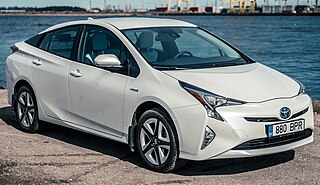
The Toyota Prius is a compact/small family liftback produced by Toyota. The Prius has a hybrid drivetrain, combined with an internal combustion engine and an electric motor. Initially offered as a four-door sedan, it has been produced only as a five-door liftback since 2003.

The Honda Insight is a hybrid electric vehicle that is manufactured and marketed by Honda. Its first generation was a two-door, two passenger liftback (1999–2006) and in its second generation was a four-door, five passenger liftback (2009–2014). In its third generation, it became a four-door sedan (2018–2022). It was Honda's first model with Integrated Motor Assist system and the most fuel efficient gasoline-powered car available in the U.S. without plug-in capability — for the length of its production run.

The Toyota Avalon is a full-size sedan produced by Toyota. It is Toyota's largest front-wheel drive sedan and serves as its flagship sedan in the United States, Canada, China and the Middle East. It was also produced in Australia from April 2000 until June 2005, when it was replaced in November 2006 by the Aurion. The first production Avalon rolled off the TMMK assembly line in Georgetown, Kentucky, in September 1994, and subsequent generations have all been manufactured at the Kentucky location to date.

The Ford Escape is a compact crossover SUV sold by Ford since the 2001 model year. The first Ford SUV derived from a car platform, the Escape was slotted below the Ford Explorer in size; the Escape is currently sized between the Ford EcoSport and Ford Edge. In another first, the 2004 Ford Escape Hybrid was the first hybrid-electric vehicle from Ford, and the first hybrid produced as an SUV.

The Toyota RAV4 EV is an all-electric version of the popular RAV4 SUV produced by Toyota until 2014. Two generations of the EV model were sold in California, and to fleets elsewhere in the US, with a gap of almost ten years between them.

The Ford Fusion Hybrid is a gasoline-electric hybrid powered version of the mid-sized Ford Fusion sedan manufactured and marketed by Ford, now in its second generation. A plug-in hybrid version, the Ford Fusion Energi, was released in the U.S. in February 2013.

The Ford C-Max is a car produced by the Ford Motor Company from 2003 to 2019. It has a five-door compact multi-purpose vehicle (MPV) design. The Ford Grand C-Max has a longer wheelbase.
Hybrid Synergy Drive (HSD), also known as Toyota Hybrid System II, is the brand name of Toyota Motor Corporation for the hybrid car drive train technology used in vehicles with the Toyota and Lexus marques. First introduced on the Prius, the technology is an option on several other Toyota and Lexus vehicles and has been adapted for the electric drive system of the hydrogen-powered Mirai, and for a plug-in hybrid version of the Prius. Previously, Toyota also licensed its HSD technology to Nissan for use in its Nissan Altima Hybrid. Its parts supplier Aisin Seiki Co. offers similar hybrid transmissions to other car companies.

A plug-in hybrid electric vehicle (PHEV) is a hybrid electric vehicle whose battery pack can be recharged by plugging a charging cable into an external electric power source, in addition to internally by its on-board internal combustion engine-powered generator. Most PHEVs are passenger cars, but there are also PHEV versions of sports cars, commercial vehicles and vans, utility trucks, buses, trains, motorcycles, mopeds, and even military vehicles.

The Toyota Highlander, also known as the Toyota Kluger, is a mid-size crossover SUV with three-row seating produced by Toyota since 2000.
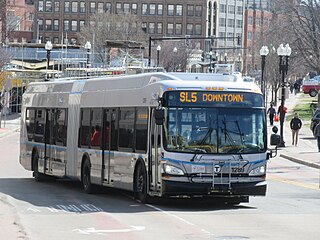
A hybrid electric vehicle (HEV) is a type of hybrid vehicle that combines a conventional internal combustion engine (ICE) system with an electric propulsion system. The presence of the electric powertrain is intended to achieve either better fuel economy than a conventional vehicle or better performance. There is a variety of HEV types and the degree to which each function as an electric vehicle (EV) also varies. The most common form of HEV is the hybrid electric car, although hybrid electric trucks, buses, boats and aircraft also exist.

Miles per gallon gasoline equivalent is a measure of the average distance traveled per unit of energy consumed. MPGe is used by the United States Environmental Protection Agency (EPA) to compare energy consumption of alternative fuel vehicles, plug-in electric vehicles and other advanced technology vehicles with the energy consumption of conventional internal combustion vehicles rated in miles per U.S. gallon.
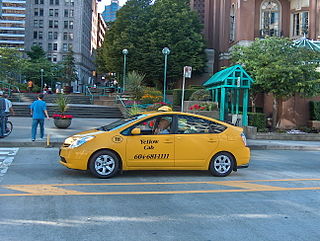
Hybrid taxi or hybrid electric taxi is a taxicab service provided with a hybrid electric car (HEV), which combines a conventional internal combustion engine propulsion system with an electric propulsion system.

The Toyota Prius Plug-in Hybrid is a plug-in hybrid liftback manufactured by Toyota. The first-generation model was produced from 2012 to 2016. The second-generation model has been produced since 2016. Production of the third-generation model began in 2023.
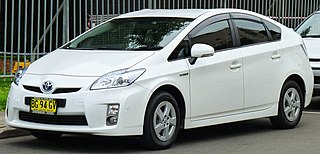
The third generation Toyota Prius debuted as a compact liftback manufactured and marketed by Toyota, having launched in 2009 for model year 2010 at the January 2009 North American International Auto Show. Internally designated as model XW30 and replacing the XW20 series, sales began in Japan on May 18, 2009.

The Toyota Prius (XW10) is a subcompact hybrid car that was produced by Toyota between 1997 and 2003 in Japan. The XW10 is divided into the NHW10 and its NHW11 counterpart, both of which represent the first generation of Prius series. The Toyota Prius is the first mass-produced hybrid car, and was released 2 years ahead of other manufacturers. While the NHW10 was available exclusively to Japan, it was subsequently introduced to worldwide markets in September 2000 with the NHW11. Toyota sold about 123,000 first generation Prius. Toyota's XW10 series Prius is notable as the first vehicle based on the Toyota MC platform.

The Toyota Priusv, also named Prius α in Japan, and Prius+ in Europe and Singapore, is a hybrid gasoline-electric automobile produced by Toyota introduced in Japan in May 2011, in the U.S. in October 2011, and released in Europe in June 2012. The Prius v was unveiled at the January 2011 North American International Auto Show alongside the Prius c Concept, and it is the first Prius variant to be spun off from the Prius platform. According to Toyota the "v" stands for "versatility". It is a compact MPV with a standard full hybrid drivetrain.

The Hyundai Ioniq is a compact five-door liftback manufactured and marketed by Hyundai. The nameplate Ioniq is a portmanteau of ion and unique. It is marketed as the first automobile to be offered without a standard internal combustion engine, but rather sold in hybrid, plug-in hybrid, and all-electric variants.

The fourth-generation Toyota Prius was first shown during September 2015 in Las Vegas, and was released for retail customers in Japan on 9 December 2015. The launch in North American market occurred in January 2016, and February in Europe and the Middle East. Toyota expected to sell 12,000 fourth generation Prius cars a month in Japan, and to reach annual sales between 300,000 and 350,000 units.








